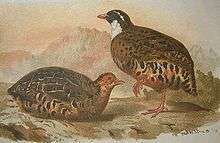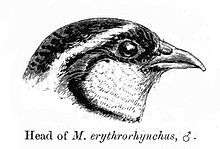Painted bush quail
| Painted bush quail | |
|---|---|
 | |
| A male from the Nilgiris | |
| Scientific classification | |
| Kingdom: | Animalia |
| Phylum: | Chordata |
| Class: | Aves |
| Order: | Galliformes |
| Family: | Phasianidae |
| Subfamily: | Perdicinae |
| Genus: | Perdicula |
| Species: | P. erythrorhyncha |
| Binomial name | |
| Perdicula erythrorhyncha (Sykes, 1832) | |
| Synonyms | |
|
Microperdix erythrorhynchus | |
The painted bush quail (Perdicula erythrorhyncha) is a species of quail found in the hill forests of India. They move in small coveys on hillsides and are distinguished by their red bills and legs. They have a liquid alarm call and small groups will run in single file along paths before taking flight when flushed.
Description

This quail is darkish brightly colored with a deep red bill and legs, eye-catching even in flight. The female has brick-red underpart and lacks the white throat and head stripe of the male. The male has a black face with a white supercilium and throat. These quail are typically found in a covey of 6 to 10 birds. They come out in open grassy patches or on forest roads and cart tracks to feed and dust-bathe in the morning and evening. The covey quickly reunites by the constant call of the members to one another. The call consists of runs of soft whistle for rallying the scattered covey. The call is pleasant, oft-repeated triple note kirikee-kirikee-kirikee,[2] by the cock in breeding season.[3][4]
It is 6.6–7.5 in (17–19 cm) in length and weighs roughly 2.4–3.1 oz (68–88 g)[5]
Distribution and habitat
This species is mainly found in the hill forests. There are two apparently disjunct populations. Subspecies blewitti is found in the Satpuras and extends into the northern Eastern Ghats. This is smaller and paler than the nominate subspecies of the Western Ghats (south of Pune), the Nilgiris and hills of southern India including the Biligirirangans and Shevaroys.[3]
Behaviour and ecology

These quails are usually seen in small groups of 8 to 10. When flushed they scatter in different directions and then begin rally calling to reunite. Males are believed to be monogynous.[6] They are pugnacious and trappers are known to use decoy males to capture others.[7] The call of the breeding male is a kirkee..kirkee and other calls include soft whistles which rises and falls in pitch.[6] The nesting season varies locally, but is said to breed mainly in December to March. Nests are typically found in the ground at the root of a bush or grass clump, sometimes thinly lined with grass. The female lays 4 to 7 eggs at a time, which are incubated by the female alone for 16–18 days before hatching. Females are said to defend their young often by attacking dogs and even humans that intrude.[8] Chicks are said to be able to fly at a very early age.[6]
References
- ↑ BirdLife International (2012). "Perdicula erythrorhyncha". IUCN Red List of Threatened Species. Version 2013.2. International Union for Conservation of Nature. Retrieved 26 November 2013.
- ↑ Primrose,AP (1916). "Notes on the Painted Bush Quail Microperdix erythrorhynchus F.B.I. 1359". J. Bombay Nat. Hist. Soc. 24 (3): 597.
- 1 2 Jerdon, TC (186). The Birds of India. Volume 3. George Wyman & Co. pp. 584–585.
- ↑ Rasmussen PC & JC Anderton (2005). Birds of South Asia: The Ripley Guide. Volume 2. Smithsonian Institution & Lynx Edicions. pp. 125–126.
- ↑ Hume, A.O.; Marshall, C.H.T. (1880). Game Birds of India, Burmah and Ceylon II. Calcutta: A.O. Hume and C.H.T. Marshall. p. 127.
- 1 2 3 Ali, S & SD Ripley (1980). Handbook of the Birds of India and Pakistan. Volume 2 (2 ed.). Oxford University Press. pp. 51–53.
- ↑ Baker,EC Stuart (1924). "The game birds of India, Burma and Ceylon. Part 37". J. Bombay Nat. Hist. Soc. 29 (4): 850–863.
- ↑ Daly,WM (1887). "The Bush Quail Perdicula erythroryncha". J. Bombay Nat. Hist. Soc. 2 (2): 149.
